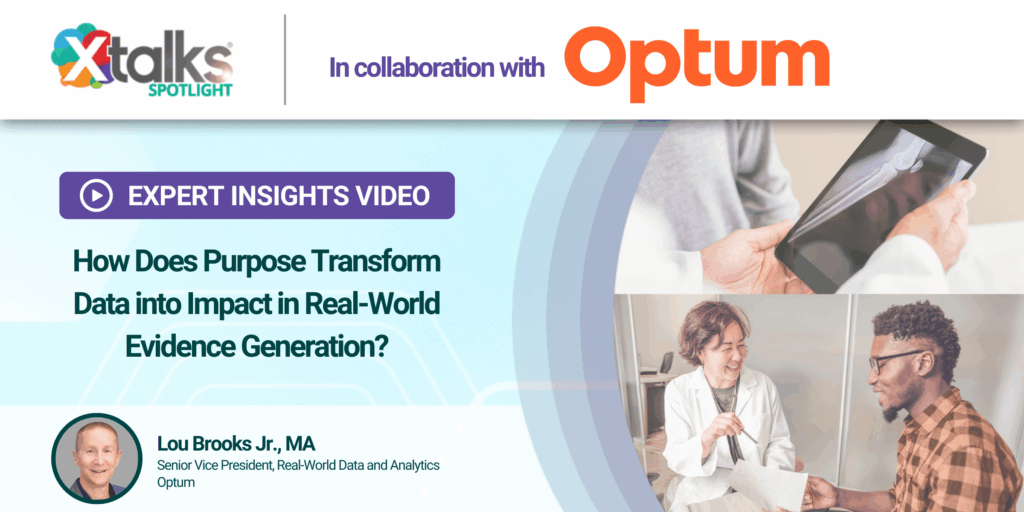Real-world evidence generation has become central to how life sciences companies approach research, development and commercialization.
Yet the data needed to build that evidence is often fragmented, spread across claims, electronic medical records (EMRs), clinical notes, imaging reports and other formats that are not always easy to access or analyze. This fragmentation can limit researchers’ ability to fully understand patient journeys, track disease progression and evaluate therapeutic outcomes.

Senior Vice President
Real-World Data and Analytics
Optum Life Sciences
In this Xtalks Spotlight interview, Lou Brooks Jr., Senior Vice President of Real-World Data and Analytics at Optum Life Sciences, explains how aligning data with purpose helps overcome these challenges.
With more than 25 years of experience leading analytics teams across industries, including nearly three decades in pharmaceutical data and research, Lou offers a perspective on how the right frameworks, enrichments and timing can transform raw information into evidence that serves meaningful goals.
Real-World Evidence Generation Starts with Purpose
Lou frames the concept with a simple analogy.
“Imagine that you have a very small, very thin finish nail that you want to knock into your trim. You wouldn’t use a 10-pound sledgehammer to do that. It’s not going to work properly, right? You’re going to find the right tool to actually drive that nail in. And data is much the same way.”
He added that projects often fail because they begin without a clear plan. Too many teams skip past the fundamental step of defining what business questions they want answered and which data elements are absolutely necessary. This is the “critical aspect” of ensuring data meets its intended purpose.
Lou also emphasized that no single dataset can serve every purpose. Each research question requires its own match between hypothesis and data source. That’s why he advocates for a structured rubric: organizations should routinely ask themselves, and their data, whether the assets they are considering truly contain the measures needed.
The key is starting with the right question, underlined Lou.
Claims data may reveal billing and utilization patterns, but it cannot capture measures like blood pressure or body mass index. He noted that fit for purpose cannot be declared by the data provider alone; it lies in the eye of the end user who must ensure that the dataset aligns with the hypothesis being tested.
Without this upfront clarity, projects could risk stalling halfway through.
Enriching Data Beyond the Basics
For many years, administrative health claims formed the foundation of real-world evidence. Thousands of studies were built on this single data type.
By the mid-2000s, however, electronic medical records (EMRs) became more widely used and today represent another core source for research. Even so, EMRs bring their own limitations. Structured fields capture only a fraction of what is documented.
“Getting to the details that a provider, a doctor, a nurse practitioner, physician assistant, a nurse are documenting in the unstructured portion or the notes of that electronic medical record system is essential to filling in those gaps,” explained Lou.
Lou described enrichment as a layered process. It begins with extracting information from unstructured clinical notes, then expands outward to incorporate genomic data, imaging results and even information generated by wearables like smartwatches. Bringing these different elements together may rely on advanced analytic methods or human review to ensure they are meaningfully connected back to the foundational dataset.
He cautioned that these efforts are only worthwhile when they serve the purpose of the research.
Enrichment, he explains, is not about collecting more data for its own sake but about building a more comprehensive view of patient care that directly supports the questions being asked.
Why Data Enrichment Can’t Wait
The process of enrichment cannot be rushed. Projects may take 30 days or stretch to nine months, depending on their complexity.
For Lou, the answer to when to start is simple: “As soon as you can.”
He explained that organizations should be thinking about the lifecycle of their products well in advance, mapping out not only launch strategies but also future evidence needs.
At the point of launch, clinical trial data may be sufficient to support a label and marketing claims. Over time, however, new questions inevitably emerge. Companies may find themselves needing head-to-head comparisons against competitors, safety studies in broader populations or evidence of benefits in patients with comorbid conditions.
Because these projects take time to set up, Lou advised that companies lay out a plan early and engage with the organizations that compile and make data available for research. That way, the necessary frameworks are in place when the questions arise. Otherwise, delays in obtaining data can erode the value of the answers.
Lou assured that most clients understand that time is money. The longer it takes to resolve a question, the less impact the evidence will have on a product’s positioning.
Meeting Diverse Data Needs
Addressing diverse evidence needs across therapeutic areas requires a mix of vigilance and flexibility.
Lou explained that his team not only works closely with clients but also tracks developments across journals and media to stay ahead of where attention is shifting. This allows them to anticipate areas that may require enrichment, such as the surge of interest in GLP-1 therapies or the heightened focus on rare diseases driven by advocacy and clinical development.
“Pulling that all together is a lot more art than it is science, but it’s extremely important in terms of laying out the roadmap.”
Still, the sheer scale of the healthcare landscape makes prioritization unavoidable. There are thousands of diseases and thousands of products, both in development and already on the market. In addition, not every request can be addressed at once, and in some cases, it may be a year or two before certain conditions are reached on the list.
This means balancing investment in high-impact areas with creating pathways for organizations to access data in other ways. Lou highlighted that the focus is not only on what enrichments are built but also on how they are made available, ensuring that even when his team cannot directly support an area, companies can still find ways to pursue the evidence they need.
What’s Next for Real-World Evidence: Regulation and Precision
Lou saw two forces shaping real-world evidence generation over the next 12 to 18 months. The first is regulatory direction.
Agencies such as the FDA, CDC and the Department of Health and Human Services (HHS) are actively considering how to refine their guidance, and any modifications will have a direct effect on how and where real-world data is applied in regulatory settings. For Lou, these frameworks represent one of the most impactful drivers of adoption.
The second is precision medicine. While the term has been in circulation for years, the reality of patient care still relies on a significant degree of trial and error. At the same time, recent years have brought notable progress. Biomarkers have shown real success in the last four to five years, particularly in the context of cell and gene therapies, offering proof points of how targeted approaches can work.
“As the population continues to age, as we all start to suffer from certain diseases that just eventually catch up to us, no matter how healthy we are, no matter how good our habits are, there is some predisposition to all of us based on our genetic makeup for certain conditions. We have to be ready to meet them when and if they present themselves,” pointed out Lou.
Meeting these challenges would require not only better datasets but also greater transparency and trust in the analytic foundations built on them.
In our interview, Lou underscored a central principle: data alone is not enough. Its value depends on being fit for purpose, enriched appropriately and made available at the right time.
This article was created in collaboration with the sponsoring company and the Xtalks editorial team.








Join or login to leave a comment
JOIN LOGIN